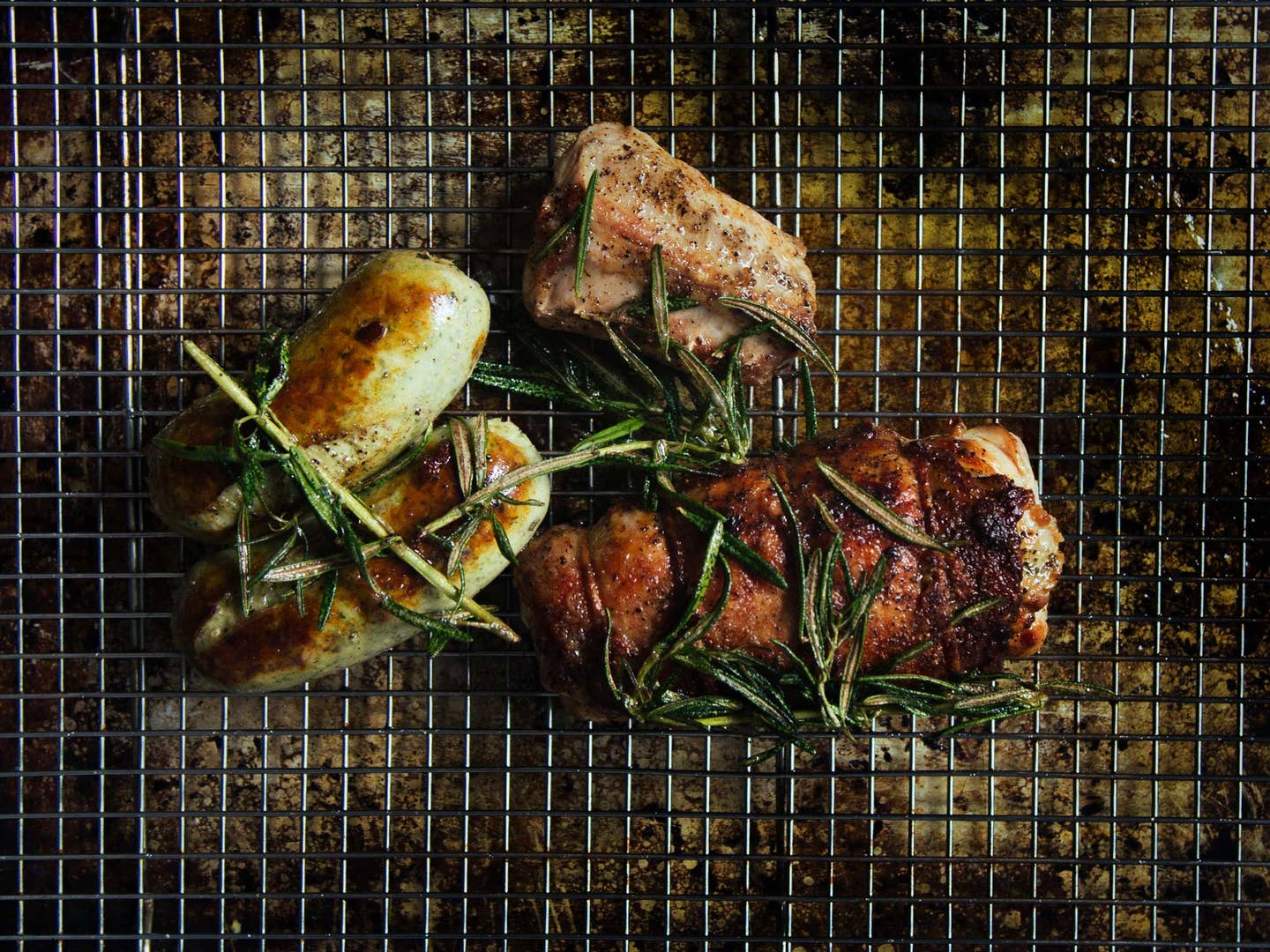
A comforting cool weather dish, chef Nick Anderer's coniglio al forno provides expert instruction in breaking down a whole rabbit (which any good butcher can do on-site as well) for the avid home butcher. With savory dark olives, plenty of acid, and salty prosciutto and soppressata, the rabbit parts are beautifully seared and browned from pan- and oven-roasting. Often, the whole rabbit does not come with liver, heart, and kidneys, in which case eliminate the applicable steps.
What You Will Need
ADVERTISEMENTADAD
Ingredients
For the sauce
- 1 cup chopped prosciutto and soppressata (use the ends or other trim pieces if you have them)
- 2 small shallots, thinly sliced
- 1 sprig rosemary, plus 1 Tbsp. fresh rosemary leaves
- 2 cloves garlic, minced
- 1 cup white wine, plus a splash more
- 1⁄4 cup white wine vinegar
- 2 cups brown rabbit or chicken stock
- 2 tbsp. olive oil
- 1⁄2 cup pitted taggiasca olives
- 1 lemon wedge, for squeezing
- Kosher salt
For the rabbit
- 1 4-5 lb. rabbit
- 1⁄2 tsp. finely chopped fresh rosemary, plus 1 sprig rosemary
- Freshly ground black pepper
- Kosher salt
- 4 oz. Rabbit Sausage with Fennel, Chili Flakes, and Broccoli Rabe
- 2-3 tbsp. olive oil
- 2 tbsp. unsalted butter
Instructions
Step 1
To make the sauce: In a large skillet over medium-high heat, add the prosciutto and soppressatta. Cook, stirring occasionally, until some of the fat renders. Add the shallots, rosemary, and garlic and cook, stirring, for 1 minute. Stir in the white and vinegar. Cook until the liquid is almost completely evaporated, then stir in the stock. Simmer for 30 minutes, then strain. Set aside.
Step 2
To make the rabbit, set aside the heart, kidney and livers. Detach the hind legs and front shoulders. Cut away the meat for both and set aside for sausage. Remove the rib rack from the front end of the center section and French the bones. You will be left with the center loin section with two flaps hanging off either side. Remove one of the flaps and set aside for sausage. Keep the other flap attached and pound it out thin until it reaches ¾ of the way around the loin. Season the inside of the flap with chopped rosemary and black pepper and wrap it around the bone-in loin, tying it in three places to hold the flap in place.
Step 3
When ready to roast, preheat the oven to 450°. Season the outside of the wrapped loin and the rack with salt and pepper.
Step 4
Heat a large skillet over medium-high heat. Add the olive oil and heat until hot but not smoking. Add the wrapped loin flap side down. Let cook, rotating as needed, until dark golden brown on all sides. Place the loin back on the flat flap side, then add the sausage to the pan. Transfer the skillet to the oven and cook 3 to 5 minutes or when evenly browned with an internal temperature of 125° when checked with a meat thermometer.
Step 5
Remove the pan from oven and set over medium heat on the stove. Add the butter and a rosemary sprig and cook until the butter is melted and hot. Add the rack and, using a spoon, baste the sausage, rack and the loin with the melted butter for 1-2 minutes.
Step 6
Remove all of the meat from the pan to a resting rack, and drizzle the excess hot butter and rosemary over the meat. Let rest for at least 5 minutes and up to 15 minutes. Do not clean out the pan; set aside.
Step 7
Meanwhile, season the liver, heart, and kidney with salt and pepper. In a separate small skillet, add 1 tablespoon butter and a sprig of rosemary and cook, turning once, 30 seconds per side, being careful to leave the offal medium rare. Remove and transfer to a cutting board.
Step 8
Slice all the offal in half to expose the rosy interiors. Remove the seared flap from the loin meat and cut into strips. Remove the loin meat from the bone, slice the sausage, and arrange everything, including the rack, on the plate.
Step 9
Working quickly, finish the sauce: Add the olive oil to the reserved skillet over medium heat. Once hot, add the rosemary leaves and olives; cook until lightly fried, about 1 minute. Pour in a splash of white wine and ½ cup of the prepared sauce. Bring to a simmer and add a squeeze of fresh lemon juice. Taste and adjust the seasoning with salt and pepper.
Keep Reading
Continue to Next Story
ADVERTISEMENTADAD










